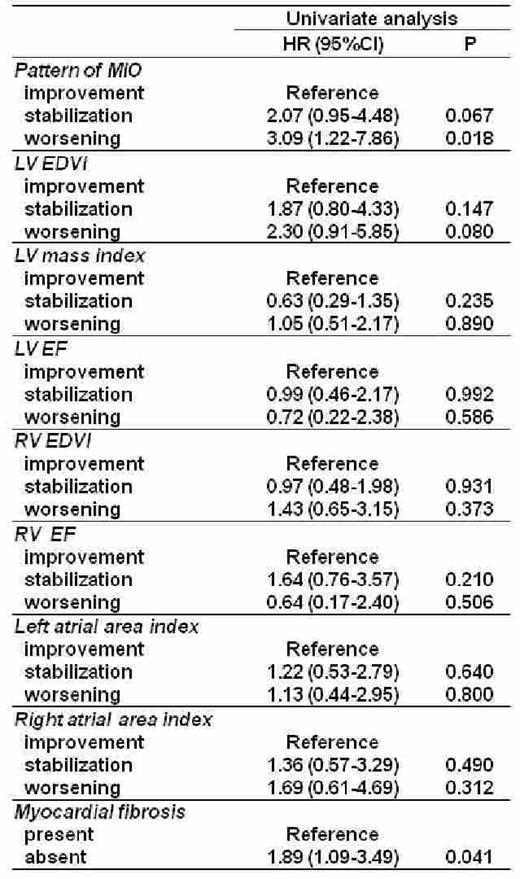Abstract
Introduction. Cardiovascular magnetic Resonance (CMR) has dramatically changed the clinical practice and improved the prognosis in thalassemia major (TM). This is the first study evaluating the predictive value of changes in CMR parameters (myocardial iron, function, and fibrosis) for cardiac complications in TM.
Methods. We followed prospectively 709 TM patients (374 females; 29.77±8.53 years) consecutively enrolled in the Myocardial Iron Overload in Thalassemia (MIOT) Network who performed a baseline and a 1 st follow up CMR scan after 18 months. Myocardial iron overload (MIO) was measured by multislice multiecho T2* technique and atrial dimensions and biventricular function by cine images. Macroscopic myocardial fibrosis was detected by late gadolinium enhancement technique.
Risk classes were defined based on the 4 patterns of MIO from worst to normal. For patients with baseline MIO (at least one segmental T2*<20 ms), improvement was defined as a transition to a better risk class, stabilization as no change in risk class, and worsening as a transition to a worse risk class. For patients without baseline MIO, the worsening was the transition to a worse risk class.
The percentage change was used for continuous variables. For biventricular ejection fractions, improvement was a %change>10%, stabilization a %change between -10% and 10%, and worsening a %change<-10%. For biventricular volumes, LV mass index, and atrial areas, improvement was a % change<-10%, stabilization a % change between -10% and 10%, and worsening a % change>10%.
Myocardial fibrosis was considered absent if not detected in any of the two CMRs and present if detected in at least one examination .
Results. During a mean follow-up of 89.4±33.3 months, cardiac events were recorded in 50 (7.1%) patients: 24 (48%) episodes of heart failure, 24 (48%) arrhythmias (23 supraventricular and 1 hypokinetic), and 2 (4.0%) pulmonary hypertension. Mean time from the 1 st follow up CMR to the development of a cardiac complication was 75.31±35.35 months.
In the univariate Cox regression analysis, cardiac iron cleareance and myocardial fibrosis were identified as univariate prognosticators (Table 1). In the multivariate analysis only myocardial fibrosis remained an independent predictor factor.
Conclusion. The presence of myocardial fibrosis at the baseline CMR or developed within 18 months emerges as the strongest long-term predictor for cardiac complications in TM. Our data demonstrate the importance in using the contrast medium for CMR scans in thalassemia patients.
Pepe: Bayer S.p.A.: Other: no profit support; Chiesi Farmaceutici S.p.A: Other: no profit support. Maggio: Novartis: Membership on an entity's Board of Directors or advisory committees; Celgene Corp: Membership on an entity's Board of Directors or advisory committees; Bluebird Bio: Membership on an entity's Board of Directors or advisory committees.


This feature is available to Subscribers Only
Sign In or Create an Account Close Modal